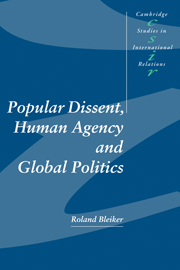Book contents
- Frontmatter
- Contents
- Acknowledgements
- Prologue: Theorising transversal dissent
- Introduction: Writing human agency after the death of God
- Part I A genealogy of popular dissent
- 1 Rhetorics of dissent in Renaissance Humanism
- 2 Romanticism and the dissemination of radical resistance
- 3 Global legacies of popular dissent
- Part II Reading and rereading transversal struggles
- Part III Discursive terrains of dissent
- Conclusion: The transitional contingencies of transversal politics
- Index
- CAMBRIDGE STUDIES IN INTERNATIONAL RELATIONS
2 - Romanticism and the dissemination of radical resistance
Published online by Cambridge University Press: 23 October 2009
- Frontmatter
- Contents
- Acknowledgements
- Prologue: Theorising transversal dissent
- Introduction: Writing human agency after the death of God
- Part I A genealogy of popular dissent
- 1 Rhetorics of dissent in Renaissance Humanism
- 2 Romanticism and the dissemination of radical resistance
- 3 Global legacies of popular dissent
- Part II Reading and rereading transversal struggles
- Part III Discursive terrains of dissent
- Conclusion: The transitional contingencies of transversal politics
- Index
- CAMBRIDGE STUDIES IN INTERNATIONAL RELATIONS
Summary
At certain moments in history a strong inspiration takes hold of the masses; then their breathing, their words, and their movements merge to the point that nothing can resist them'.
The previous chapter has shown how Renaissance humanists stepped out of the theocentric medieval discourse and placed ‘man’ at the centre of the world. Taking Étienne de la Boétie's Anti-One as an example, it demonstrated how the notion of popular dissent reemerged, first as a rhetorical argument, and then as a practice of political protest. The present chapter examines how this early and often tentative articulation of resistance turned into a coherent tradition of popular dissent – one that started to influence social dynamics far beyond the boundaries of Europe. The political dimensions of this tradition thus took on increasingly transversal characteristics – not yet in the sense that protest acts acquired an immediate global dimension, but insofar as the theory and practice of popular dissent gradually came to influence the thoughts and actions of an ever-wider populace.
The dissemination and maturation of popular resistance is observed as a way of continuing the genealogical inquiry into the framing of human agency and transversal dissent. The focus now lies with the period between the seventeenth and the nineteenth century. La Boétie remains central, or at least the dancing shadows of his quill.
- Type
- Chapter
- Information
- Popular Dissent, Human Agency and Global Politics , pp. 74 - 95Publisher: Cambridge University PressPrint publication year: 2000



